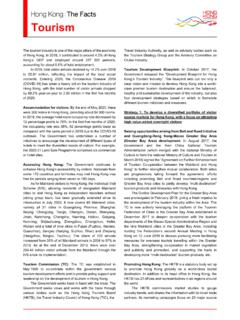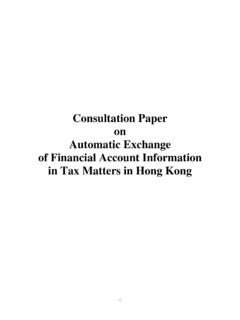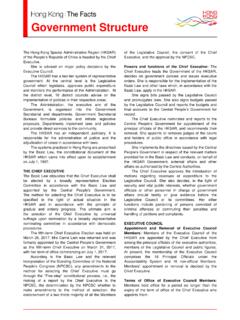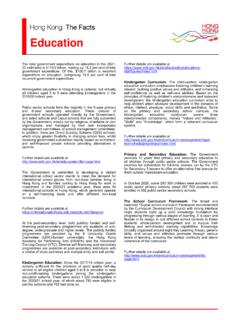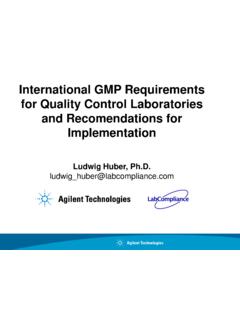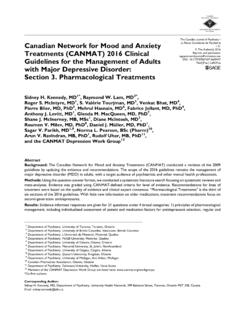Transcription of Mandatory Provident Fund
1 HONG KONG : THE FACTSM andatory Provident fund Hong Kong has a rapidly ageing population. People aged 65 and above accounted for 15 per cent of the population in 2014. This proportion is estimated to increase to 28 per cent by 2034, and to 33 per cent by 2064. Before the implementation of the Mandatory Provident fund ( MPF ) System in December 2000, only about one-third of the workforce of million people had retirement protection. Up to now, around 85 per cent of the working population is already under retirement protection. In August 1995, Hong Kong took a major step in enacting the Mandatory Provident fund Schemes Ordinance ( MPFSO ) (Chapter 485, Laws of Hong Kong) to provide a formal system of retirement protection.
2 The MPFSO provides a framework for establishing a system of privately managed, employment-related MPF schemes for members of the workforce to accrue financial benefits for retirement. The Mandatory Provident fund Schemes Authority ( MPFA ) was established on September 17, 1998 to regulate, supervise and monitor the operation of the MPF System. The MPF System has come into operation since December 1, 2000. About Mandatory Provident fund The MPF System: The MPF System is the second pillar of the multi-pillar retirement protection framework* recommended by the World Bank.
3 The key features of the MPF System include: Coverage: All employees and self-employed persons aged 18 to 64, unless exempt under the MPFSO, are covered by the MPF System. Exemption: Under the MPFSO, the following are exempt persons who are not required to join an MPF scheme: persons covered by statutory pension or Provident fund schemes ( civil servants, judicial officers, and teachers in subsidised or grant schools); members of occupational retirement schemes regulated under the Occupational Retirement Schemes Ordinance ( ORSO ) (Chapter 426, Laws of Hong Kong) that are granted exemption under the MPFSO ( MPF-exempted ORSO schemes).
4 Persons from overseas who enter Hong Kong for employment or self-employment - for not more than 13 months; or who are members of retirement schemes of a place outside Hong Kong; employees of the European Union Office of the European Commission in Hong Kong; domestic employees; and self-employed hawkers. Employees who are employed for less than 60 days, excluding casual employees as defined under the MPFSO^, are also exempt from joining an MPF scheme. Mandatory contributions: An employee and his/her employer are both required to contribute five per cent of the employee s relevant income as Mandatory contributions for and in respect of the employee to an MPF scheme, subject to a maximum relevant income level for contribution purposes (currently, $30,000 per month or $1,000 per day).
5 An employee whose income is less than the minimum level of relevant income (currently, $7,100 per month or $280 per day) is not required to contribute. However, his/her employer is still required to make Mandatory contributions for him/her. Self-employed persons also have to contribute five per cent of their relevant income as Mandatory contributions, subject to the minimum and maximum levels of relevant income for contribution purposes. The MPF legislation provides that MPFA must, not less than once in every period of four years, conduct a review of the minimum and maximum levels of relevant income for MPF contribution purposes to ascertain whether or not there are grounds to amend the levels.
6 Vesting: Any Mandatory contributions paid to an MPF scheme for and in respect of an employee and any investment return derived from the investment of the Mandatory contributions are fully and immediately vested in the employee as accrued benefits ( accumulated contributions and investment returns), except for those derived from the employer s Mandatory contributions which can be used for offsetting severance payments and long service payments. Similarly, contributions made by a self-employed person and the related investment return are fully and immediately vested in the person.
7 Preservation of benefits: Accrued benefits derived from Mandatory contributions must be preserved until a scheme member reaches the retirement age of 65 or satisfies other circumstances specified in the MPFSO, namely early retirement on attaining the age of 60, permanent departure from Hong Kong, total incapacity, terminal illness, small balance of $5,000 or less in an MPF scheme, and death. Portability of benefits: When an employee ceases employment or changes jobs, he/she can transfer the accrued benefits from his/her contribution account to: a contribution account in his/her new employer s MPF scheme; or an MPF personal account in any MPF schemes (excluding an employer sponsored scheme).
8 Furthermore, under the Employee Choice Arrangement, an employee can, during employment, elect to transfer his/her accrued benefits derived from the employee s Mandatory contributions made during current employment from the employee s contribution account to an MPF personal account in any MPF scheme of his/her own choice once every calendar year. Voluntary contributions: Contributions paid in excess of the Mandatory amount are voluntary in nature. Employees and self-employed persons may make voluntary contributions to accumulate more accrued benefits for retirement.
9 Employers may also make voluntary contributions for their employees. Tax deduction: Subject to limits, Mandatory contributions of employees and self-employed persons, and Mandatory contributions made by employers for their employees are tax deductible. The MPF System has built in certain features to cater for the needs of the workforce, such as: No rejection requirement: All MPF trustees must not refuse applications for scheme membership made by employers on behalf of their employees or by self-employed persons. MPF Conservative fund : Each MPF scheme is required to offer a capital preservation fund , namely the MPF Conservative fund , that mainly invests in bank deposits and high-quality money market instruments.
10 This fund serves as a low-risk investment option to scheme members who are, for example, approaching retirement or unwilling to expose themselves to shorter-term market movements. Industry Schemes: Industry Schemes are established for certain high labour mobility industries. The MPFA has registered two Industry Schemes for both the construction and catering industries. Under the arrangement, members of Industry Schemes do not have to change schemes when they change employment within these two industries, thus minimising the administrative burden to employers and employees entailed by the transfer of accrued benefits from one scheme to another.




